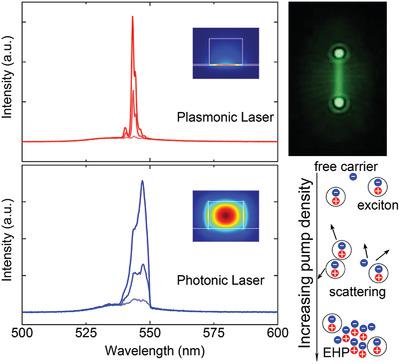当前位置:
X-MOL 学术
›
Laser Photonics Rev.
›
论文详情
Our official English website, www.x-mol.net, welcomes your
feedback! (Note: you will need to create a separate account there.)
The Electron–Hole Plasma Contributes to Both Plasmonic and Photonic Lasing from CH3NH3PbBr3 Nanowires at Room Temperature
Laser & Photonics Reviews ( IF 9.8 ) Pub Date : 2021-04-14 , DOI: 10.1002/lpor.202000512 Jian Wang 1, 2 , Xiaohao Jia 3 , Yalu Guan 1, 2 , Kuankuan Ren 4 , Haichao Yu 1, 2 , Zhijie Wang 3 , Shengchun Qu 3 , Qingxin Yang 5 , Jie Lin 1, 2 , Zhanguo Wang 3 , Peng Jin 1, 2
Laser & Photonics Reviews ( IF 9.8 ) Pub Date : 2021-04-14 , DOI: 10.1002/lpor.202000512 Jian Wang 1, 2 , Xiaohao Jia 3 , Yalu Guan 1, 2 , Kuankuan Ren 4 , Haichao Yu 1, 2 , Zhijie Wang 3 , Shengchun Qu 3 , Qingxin Yang 5 , Jie Lin 1, 2 , Zhanguo Wang 3 , Peng Jin 1, 2
Affiliation

|
Lead halide perovskites have gained tremendous attentions in many fields, especially in nanolasers, owing to the excellent optoelectronic properties. However, the underlying lasing mechanism is not clear in both plasmonic and photonic nanolasers at room temperature. Here, the plasmonic lasers and the photonic counterparts based on organic–inorganic hybrid lead tri-bromine perovskite nanowires are achieved at room temperature and are compared in terms of lasing evolution, lasing wavelengths, and lasing dynamics. The same spectra evolution and the same emission wavelength indicate that the plasmonic and the photonic CH3NH3PbBr3 nanowire lasers have the same gain origination. The calculated Mott density lower than the threshold density and lasing photon energy lower than exciton energy prove that an electron–hole plasma contributes to both the two types of lasing actions from perovskite nanowires at room temperature. The work deepens the understanding of underlying mechanism of perovskite nanowire lasers.
中文翻译:

电子空穴等离子体有助于室温下 CH3NH3PbBr3 纳米线的等离子体和光子激光
由于优异的光电性能,卤化铅钙钛矿在许多领域受到了极大的关注,特别是在纳米激光器中。然而,在室温下等离子体和光子纳米激光器的潜在激光机制尚不清楚。在这里,等离子体激光器和基于有机-无机杂化铅三溴钙钛矿纳米线的光子激光器在室温下实现,并在激光演化、激光波长和激光动力学方面进行了比较。相同的光谱演化和相同的发射波长表明等离子体和光子 CH 3 NH 3 PbBr 3纳米线激光器具有相同的增益起源。计算出的莫特密度低于阈值密度,激光光子能量低于激子能量,证明电子-空穴等离子体在室温下对钙钛矿纳米线的两种激光作用都有贡献。这项工作加深了对钙钛矿纳米线激光器潜在机制的理解。
更新日期:2021-06-10
中文翻译:

电子空穴等离子体有助于室温下 CH3NH3PbBr3 纳米线的等离子体和光子激光
由于优异的光电性能,卤化铅钙钛矿在许多领域受到了极大的关注,特别是在纳米激光器中。然而,在室温下等离子体和光子纳米激光器的潜在激光机制尚不清楚。在这里,等离子体激光器和基于有机-无机杂化铅三溴钙钛矿纳米线的光子激光器在室温下实现,并在激光演化、激光波长和激光动力学方面进行了比较。相同的光谱演化和相同的发射波长表明等离子体和光子 CH 3 NH 3 PbBr 3纳米线激光器具有相同的增益起源。计算出的莫特密度低于阈值密度,激光光子能量低于激子能量,证明电子-空穴等离子体在室温下对钙钛矿纳米线的两种激光作用都有贡献。这项工作加深了对钙钛矿纳米线激光器潜在机制的理解。











































 京公网安备 11010802027423号
京公网安备 11010802027423号